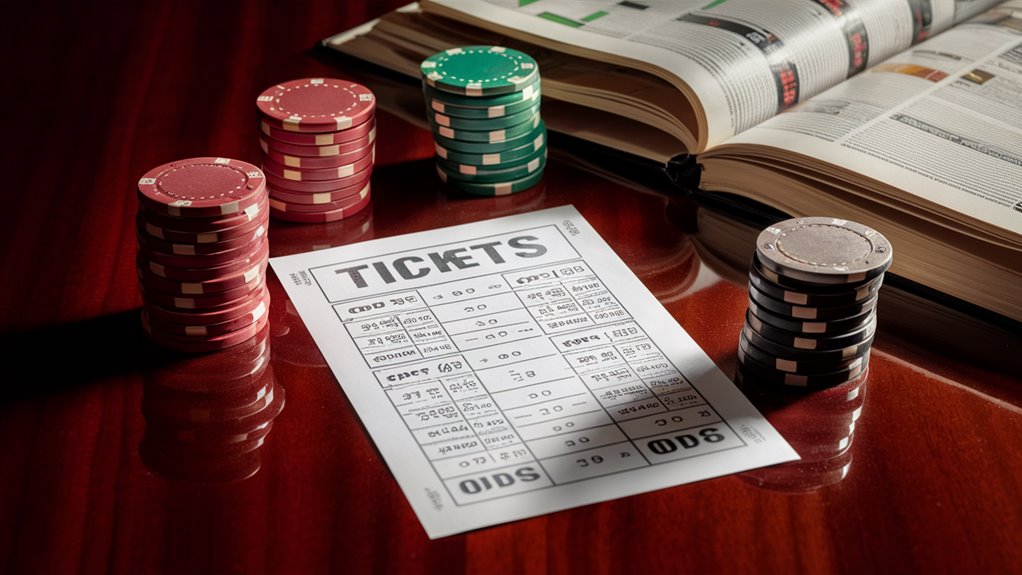
How to Read and Interpret Betting Odds
A Complete Guide to Understanding Various Betting Odds
Understanding The Three Major Formats of Odds
American Odds
American odds use plus and minus signs to indicate potential profits and required stakes. With negative odds like -150, you must bet $150 to win $100. On the other hand, positive odds like +150 mean that for every $100 you wager in exchange for these numbers you will receive 150 return.
Decimal Odds
Decimal odds express the total amount you will get back from a bet for every unit staked. A value of 2.50 means betting $1 will produce ($2.50 total, including your original stake). This form is readily understood by European punters.
Fractional Odds
Fractional odds represent your gain rate – being 5/1 winner means to say you will $5 for every $1 bet. This traditional format is still prevalent in British horse racing and other British markets.
Calculating Implied Probability
For negative American odds: |odds|/(|odds| + 100)
For positive American odds: 100/(odds + 100)
Regional Preferences
North American sportsbooks prominently display American odds.
European bookmakers prefer decimal odds.
At British betting shops, the most common odds type is fractional.
Reading Odds Resources
Types of Betting Odds
The Three Milestones in Betting Odds Systems
Whether you’re in North America, Europe, or Australia (in NZ they call it lucky 15), three primary formats of odds have been set up in use at different times: American (money-line), decimal, or fractional odds. Each system presents players with different possibilities both for bets as well as returns.
American (Moneyline) Odds
American odds, also known as moneyline odds, employ a system of plus and minus numbers. Punters must wager an extra dollar for each successful -150 bet in order to receive $100 profit. This system prevails in the sports betting markets of North America.
The Decimal Odds System
Each $1 bet in this plan counts as your entire return, including the original stake. These odds are currently being calculated in European, Australian, and Canadian betting markets. For example, a decimal odds of 2.50 means that with a $10 bet (plus $10 stake), you will receive 25 in total return: $15 profit and $10 original bet.
The Fractional Odds System
This is the traditional form of odds being used today in UK and Irish betting markets. Popular particularly among those familiar with horse racing! In this system, twice the odds directly indicate potential profit per bet. This system is less likely to be found in sports betting than it was first designed for. However, the old tried and tested system still runs.
The Advantages of Each Format
- American odds: Handy when it comes to equating underdogs against favorites.
- Decimal odds: On the whole, the easiest way to figure total returns.
- Fractional odds: Shows revenue potential clearly.
Understanding Probabilities and Payouts
Understanding Probability and Sports Betting Payouts
Converting Odds to Probability
Betting odds represent both implied probabilities and potential payouts in sports wagering. Two key formulas provide the way to reckon the probability of an event happening from American odds:
For negative odds: |Odds|/(|Odds| +100)
For positive odds: 100/(Odds + 100)
Thus, odds of -150 translate as a 60% likelihood; odds of +150 indicate a 40% chance that the event will occur.
Calculating Payouts
In order to gain success in betting, it is vital to fully understand the relationship between stake and winnings. The payout has two basic rules:
- Negative odds: Bet the amount stated and win it.
- Positive odds: Wager $100, win this amount if successful.
For example, with -150 odds, a stake of $150 will yield a profit of $100. With +150 odds, a $100 wager earns you $150.
Understanding How Sportsbooks Make Money
Vigorish is a commission paid to the bookie for accepting a bet. When bookies take bets, they are effectively laying odds on the event so that they can make money from it. So a betting market will always add up to more than 100%. Average two-way betting markets usually include a 105% margin (cost) over gambler-friendly lines where the house only speeds up play or helps good agents with research and information. It is of supreme importance to appreciate this margin in devising any betting plan or looking after your expenses.
Understanding American Odds
Understanding American Sports Betting Odds, Part I: The Basics
Fundamentals of American Odds
So with American odds, bettors obtain the kind of rate at which they stake and what the expected payout is if they win. Negative odds (-150) represent favorites, giving required stake amounts for $100 profit. Positive odds (+150) represent underdogs, yielding potential winnings on $100 bets.
Calculating Payouts with American Odds
It is extremely important to understand how payouts are calculated in sports betting. On negative odds of -150, for example, bettors must make a $150 risk for the chance at a $100 payoff. For underdog odds of +150, putting up a $100 stake will get you a $150 profit. These calculations can be appropriately calculated in proportion to each other—at -150, a $15 bet earns $10; at +150 odds, $15 of profit will be made from a $10 wager.
Converting Odds to Probabilities
American odds conversions aid in value betting through probability analysis for – and + symbols consistently mark the favorite or underdog, offering lower payouts but higher win probability.
Key Probability Conversions:
-150 odds represent a 60% probability
+150 odds signal circa 40% likelihood
Estimates as to possible outcomes become crucial to find profitable bets and to minimize risk exposure.
Decimal Odds in Focus
Understanding Decimal Odds in Sports Betting
How Decimal Odds Work
Decimal odds give gamblers the simplest method of figuring returns. With decimal odds, you just multiply your stake by a single number. For example, a $100 bet at odds of 2.50 gives possible returns of $250 ($100 x 2.50).
Pros of Decimal Formats
Compared with all other formats, the importance of precision and clarity in decimal odds is beyond doubt. Instead of using exceptional appreciation for fractions plus or minus America odds, decimal odds remove difficulties of measurement. With odds of 1.91, a bettor can tell straight off that he would make $191 on a $100 wager.
Favorites and Dogs Explained
Odds below 2.00 represent “favorites” in decimal odds; those above 2.00 are underdogs. This classifies betting markets neatly and enables a bettor to see immediately what is probability or where potential value might exist in the market.
Determining Potential Earnings
To figure out your potential profit:
Subtract 1 from the decimal odds Multiply the result by your stake Example calculation: Odds of 2.50
2.50 – 1 = 1.50 $100 x 1.50 = $150 potential profit
The Prime Virtues of Decimal Odds
Mathematical rigor in form, Universal understanding, Ingeniously precise, Quick method for deciding how much money you may well make, Simplified spotting of the best events.
Because it is a standardized format, in comparison with the others, it offers an extra advantage. And its dependence together with improved abilities for more accurate description makes this process increasingly popular among top online gambling operators as well as professional punters.
Working with Fractional Odds
Understanding Fractional Odds in Sports Betting
How to Convert Fractions to Reserve
The figure that is displayed by fractional odds Summoning Coarse Freedoms for Loud, Table-Shaking Finishes is a pair of numbers: the ratio between profit and stake. They are usually written like them to function with a slant and back-slash (5/1). The figure before the line indicates your possible profit relative to the number following it, which shows how much stake you actually have at risk.
Working with decimal odds we must bear in mind the size of our stake when calculating profit. This means that a bet at 5/1 will actually give us $5 in return for every $1 wagered. This, however, is not quite all: our original investment will also be returned. Two examples should explain this theory.
For the first, it should be realized that with fractional odds less than evens, such as 1/2: $10 bet at 1/2 = $15 total return ($5 profit + $10 stake) $100 bet at 1/2 = $150 total return ($50 profit + $100 stake)
Converting Fractions into Probability
By using the following formula, you can calculate the possibility of betting odds:
Just divide the second number by the total of the two.
Take the example for 5/1: 1 ÷ (5 + 1) = 0.167, or 16.7 percent.
Common Fractional Odds References
- Evens (1/1): Enjoy betting odds with Western bookmakers.
- American (1/2): The price Vegas bookmakers quote is one of your bets.
- Long Shots (10/1+): A more reliable way for the best ROI.
Mastering these betting calculations will enable more informed wagers and better sports betting bankroll management.
Converting Between Odds Formats
How to Convert Between Odds Formats: Full Guide
Understanding the Major Odds Formats
Bookmakers all around the world use three principal formats to display odds: fractional odds, decimal odds, and American odds (moneyline). To Infusing Salty Rival Scenes With Fiery House Momentum bet effectively and compare odds, you must change between this trio.

Converting Fractional to Decimal Odds
To convert a fraction into a decimal:
Divide the first number by the second number.
Then add 1 to the result.
Example: 5/1 becomes (5÷1) + 1 = 6.0 decimal odds.
Converting Decimal to American Odds
There are two rules for converting decimal odds to American odds:
For decimals over 2.0, multiply by (decimal – 1) x 100.
For decimals under 2.0, divide -100 by (decimal – 1).
American to Decimal Odds Conversion
To convert the odds of American decimal odds, the calculation is different according to a positive or negative value:
Positive odds (+150): Divide by 100 and add 1 (150÷100 + 1 = 2.5).
Negative odds (-150): Divide and add Connecting Light Tells for Electrifying Splitting it (100÷150 + 1 = 1.67).
Optimal Odds Conversion Practices
Although online calculators do provide an efficient method of calculating complex conversions, comprehending these elementary formulas can help bettors:
- Quickly double-check the odds.
- Locate possible pricing errors.
- Compare odds across various venues.
- Accurately prove to oneself whether the chance of such a probability exists.
Remember that the base probability behind all odds formats is unaltered–only the way of expression changes.
Popular on Betting Jargon
A Beginner’s Guide to Must-Know Sports Betting Terms and Definitions
Savvy Betting Strategies Over the Years
The Top Sports Betting Questions That You Must Know
The Favorite
The favorite in sports betting is the team or player who is expected to win, marked by a minus sign (-) in betting odds. On the other hand, the underdog, a plus sign (+) next to their name is likely to lose the game.
Point Spreads and Moneylines
The point spread sets the minimum expected understanding for a favorite to cover the spread. Moneyline betting is a straightforward method of betting. In it, you choose the team that you think will win outright without any regard to any ensuing totals.
For most wagers, bookmakers see more require a commission known as the vig or juice, commonly priced at -110.
Advanced Betting Features
In “over/under” betting–also known as “totals” with the outright aim of understanding everything well in advance–one places a wager on just how high or low the combined final score can be.
Parlay betting is when several picks are combined into a single wager for bigger payoffs, while teaser bets allow you to adjust point spreads in your favor.
Betting Propositions and Wireless
Proposition bets, or props, focus on specific in-game events or player performances.
Betting Results and Definitions
A push occurs when the final result matches exactly the spread. This means the bet is canceled.
No Action – it’s reminiscent of this, but also means that things turn out differently from what you really wanted them to do.
All these are essential betting situations which any sports bettor must know in order to succeed in making his wager.

